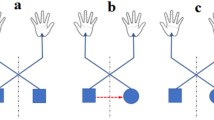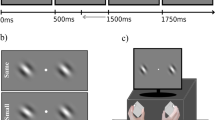Abstract
Simple visual reaction time (RT) during the performance of sagittal movements of the upper and/or lower limbs was investigated. Experiment 1 demonstrated that RTs increased when more limbs were to be moved simultaneously. This effect was more apparent for the upper than for the lower limbs. Experiment 2 allowed a separation of RT into premotor time (PMT) and motor time (MOT) components through analysis of electromyographic activity, and showed that these longer response delays were associated with increased PMTs. This suggests that the time required for the central organization of movements increased as more limbs were to be controlled simultaneously. Compared to single-limb performance conditions, the increases in RT were much larger in the upper limbs (up to 16%) than in the lower limbs (up to 5%) when limb segments were added. During single-limb conditions, RTs in the upper limbs tended to be smaller than in the lower limbs, in accordance with efferent nerve conduction time estimates. Conversely, the lower limb(s) was (were) initiated before the upper limb(s) when both effector types were moved simultaneously. This pattern of activation is reminiscent of the organization of postural control during upright standing, where goal-directed arm activity is preceded by (bilateral) leg activity to anticipate for the upcoming postural destabilization. Finally, hemifield manipulations in experiment 2 revealed faster RTs and PMTs for stimuli presented in the right visual field in comparison with the left field. This advantage was evident for ipsilateral as well as contralateral responses and supports the pre-eminence of the left hemisphere in the complex organization of gross motor responses.
Similar content being viewed by others
References
Aglioti S, Dall' Agnola R, Girelli M, Marzi CA (1991) Bilateral hemispheric control of foot distal movements: evidence from normal subjects. Cortex 27:571–581
Bard C, Paillard J, Lajoie Y, Fleury, M, Teasdale N, Forget R, Lamarre Y (1992) Role of afferent information in the timing of motor commands: a comparative study with a deafferented patient. Neuropsychologia 30:201–206
Bashore TR (1981) Vocal and manual reaction time estimates of interhemispheric transmission time. Psych Bull 89:352–368
Benecke R, Meyer BU, Freund HJ (1991) Reorganisation of descending motor pathways in patients after hemispherectomy and severe hemispheric lesions demonstrated by magnetic brain stimulation. Exp Brain Res 83:419–426
Berlucchi G, Aglioti S, Tassinari G (1994) The role of the corpus callosum and bilaterally distributed motor pathways in the synchronization of bilateral upper-limb responses to lateralized light stimuli. In: Swinnen SP, Heuer H, Massion J, Casaer P (eds) Interlimb coordination: neural, dynamical, and cognitive constraints. Academic Press, San Diego, pp 209–227
Brinkman J, Kuypers HGJM (1973) Cerebral control of contralateral and ipsilateral arm, hand and finger movements in the split-brain rhesus monkey. Brain 96:653–674
Carlton LG, Carlton MJ, Newell KM (1987) Reaction time and response dynamics. Q J Exp Psychol 39:337–360
Christina RW, Rose DJ (1985) Premotor and motor reaction time as a function of response complexity. Res Q Exerc Sport 56:306–315
Colebatch JG, Gandevia SC (1989) The distribution of muscular weakness in upper motor neuron lesions affecting the arm. Brain 112:749–763
Cruse H, Warnecke H (1992) Coordination of the legs of a slowwalking cat. Exp Brain Res 89:147–156
Di Stefano M, Morelli M, Marzi CA, Berlucchi G (1980) Hemispheric control of unilateral and bilateral movements of proximal and distal parts of the arm as inferred from simple reaction time to lateralized light stimuli in man. Exp Brain Res 38:197–204
Duysens J, Tax T (1994) Interlimb reflexes during gait in cat and human. In: Swinnen SP, Heuer H, Massion J, Casaer P (eds) Interlimb coordination: neural, dynamical, and cognitive constraints. Academic Press, San Diego, pp 209–227
Glencross DJ (1972) Latency and response complexity. J Mot Behav 4:251–258
Halbertsma J 1983 The stride cycle of the cat: the modelling of locomotion by computerized analysis of automatic recordings. Acta Physiol Scand [Suppl 521]: 1–75
Henry FM, Rogers DE (1960) Increased response latency for complicated movements and a ‘memory drum’ theory of neuromotor reaction. Res Q 31:448–458
Jeeves MA (1969) A comparison of interhemispheric transmission times in acallosals and normals. Psychonom Sci 16:245–246
Kasai T, Komiyama T (1990) Effects of varying force components on EMG reaction times of isometric ankle dorsiflexion. Hum Mov Sci 9:133–147
Kasai T, Seki H (1992) Premotor reaction time (PMT) of the reversal elbow extension-flexion as a function of response complexity. Hum Mov Sci 11:319–334
Kelso JAS, Jeka JJ (1992) Symmetry breaking dynamics of human interlimb coordination. J Exp Psychol Hum Percept Perform 18:645–668
Kimura D, Archibald Y (1974) Motor functions of the left hemisphere. Brain 97:337–350
Kirk RE (1982) Experimental design: procedures for the behavioral sciences. Brooks and Cole, Belmont
Klapp ST (1975) Feedback versus motor programming in the control of aimed movements. J Exp Psychol Hum Percept Perform 104:147–153
Kuypers HGJM (1973) The anatomical organization of the descending pathways and their contributions to motor control especially in primates. In: Desmedt JE (ed) New developments in electromyography and clinical neurophysiology, vol III. Karger, Basel, pp 38–68
Liepmann H (1908) Drei Aufsätze aus dem Apraxiegebiet. Karger, Berlin
Maddess RJ, Rosenblood LK, Goldwater BC (1973) An improved technique for monitoring fixation in tachistoscopic tasks. Q J Exp Psychol 25:398–403
Marzi CA, Bisiacchi P, Nicoletti R (1991) Is interhemispheric transfer of visuomotor information asymmetric? Evidence from a meta-analysis. Neuropsychologia 29:1163–1177
Massion J (1992) Movement, posture, and equilibrium: interaction and coordination. Progr Neurobiol 38:35–56
Milner AD (1982) Simple reaction times to lateralized visual stimuli in a case of callosal agenesis. Neuropsychologia 20:411–419
Milner AD, Jeeves MA, Silver PH, Lines CR, Wilson JG (1985) Reaction times to lateralized visual stimuli in callosal agenesis: stimulus and response factors. Neuropsychologia 23:323–331
Nashner LM, Cordo PJ (1981) Relation of automatic postural responses and reaction-time voluntary movements of human leg muscles. Exp Brain Res 43:395–405
Paillard J (1948) Quelques données psychophysiologiques relatives au déclenchement de la commande motrice. Année Psychologique 47–48:28–47
Paltsev YI, Elner AM (1967) Preparatory and compensatory period during voluntary movement in patients with involvement of the brain of different localization. Biofizika 12:142–147
Poffenberger AT (1912) Reaction time to retinal stimulation with special reference to the time lost in conduction through nervous centers. Arch Psychol 23:1–73
Schmidt RA (1988) Motor control and learning. A behavioral emphasis. Human Kinetics, Champaign
Shik ML, Orlovskii GN (1965) Coordination of the limbs during running of the dog. Biofizika 10:1037–1047
Siegel D (1986) Movement duration, fractionated reaction time, and response programming. Res Q 57:128–131
Swinnen SP, Young DE, Walter CB, Semen DJ (1991) Control of asymmetrical bimanual movements. Exp Brain Res 85:163–173
Swinnen SP, Heuer H, Massion J, Casaer P (eds) (1994) Interlimb coordination: neural, dynamical, and cognitive constraints. Academic Press, San Diego
Tomberg C, Levarlet-Joye H, Desmedt JE (1991) Reaction times recording methods: reliability and EMG analysis of patterns of motor commands. Electroencephalog Clin Neurophysiol 81:269–278
Van Donkelaar P, Franks IM (1991) The effects of changing movement velocity and complexity on response preparation: evidence from latency, kinematic, and EMG measures. Exp Brain Res 83:618–632
Walter CB, Swinnen SP (1990) Asymmetric interlimb interference during the performance of a dynamic bimanual task. Brain and Cogn 14:185–200
Welford AT (1980) Reaction times. Academic Press, San Diego
Wetzel MC, Stuart DG (1977) Activation and co-ordination of vertebrate locomotion. In: Alexander RM, Goldspink G (eds) Mechanics and energetics of animal locomotion. Wiley, New York, pp 115–152
Wyke M (1971) The effects of brain lesions on the performance of bilateral arm movements. Neuropsychologia 9:33–42
Young AW (1982) Methodological and theoretical bases of visual hemifield studies. In: Beaumont JG (ed) Divided visual field studies of cerebral organisation. Academic Press, London, pp 11–27
Author information
Authors and Affiliations
Rights and permissions
About this article
Cite this article
Swinnen, S.P., Serrien, D.J., Walter, C.B. et al. The organization of patterns of multilimb coordination as revealed through reaction time measures. Exp Brain Res 104, 153–162 (1995). https://doi.org/10.1007/BF00229865
Received:
Accepted:
Issue Date:
DOI: https://doi.org/10.1007/BF00229865




